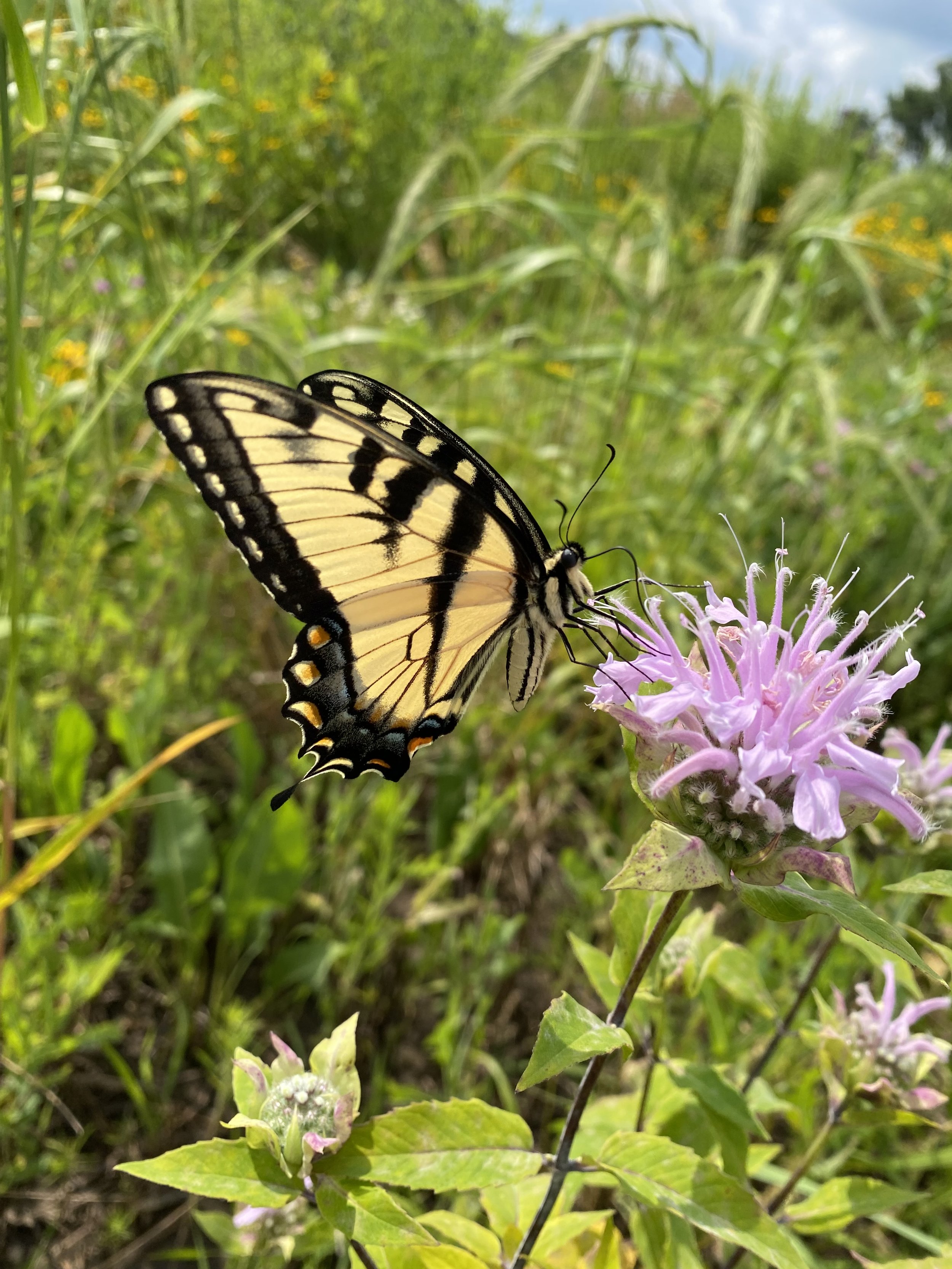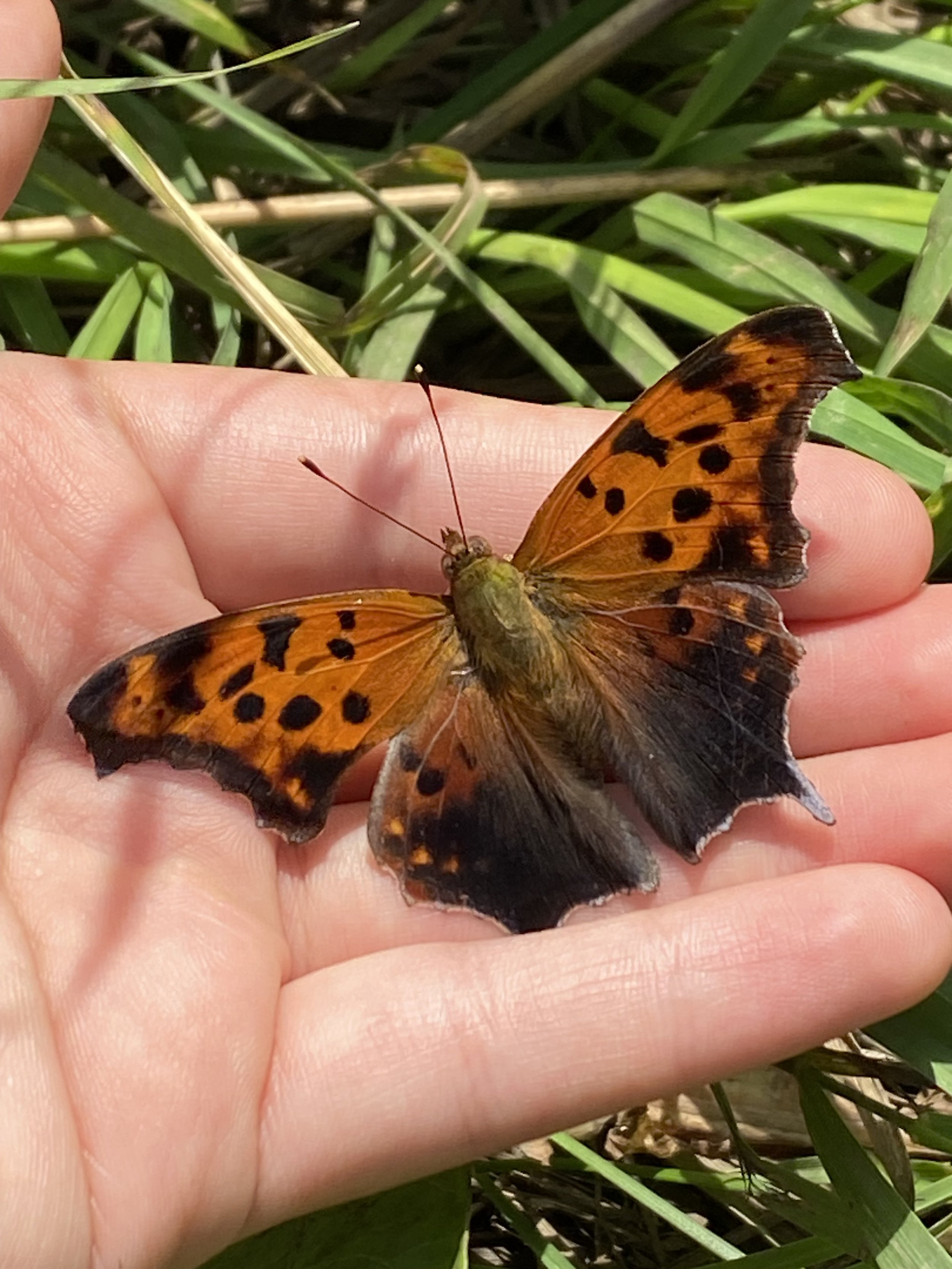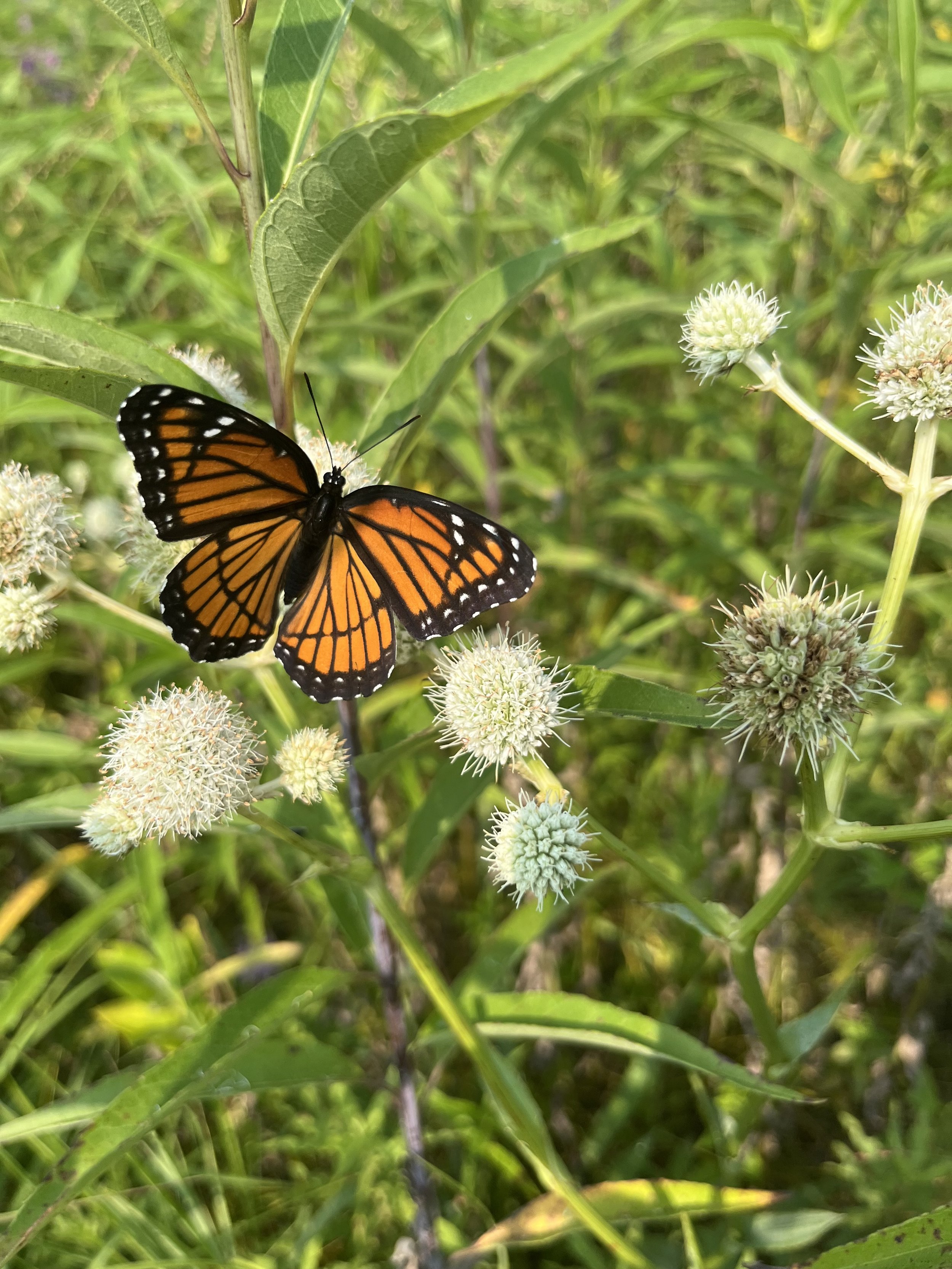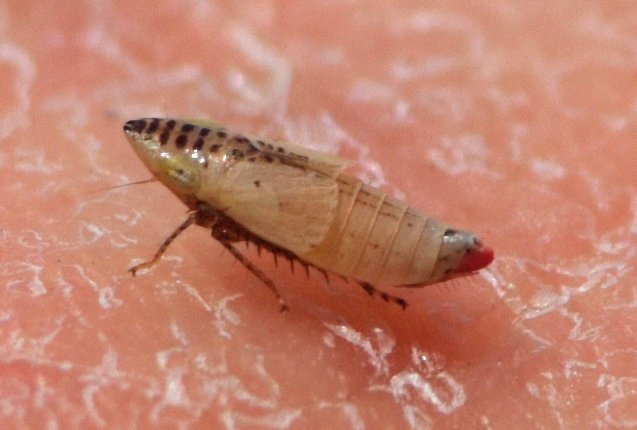Goose Pond Sanctuary Update: August 15, 2024
Southern Wisconsin Bird Alliance’s Goose Pond Sanctuary always has a ton going on. Bird conservation, habitat restoration, research, and outreach are always in season here. Learn more about Goose Pond through the update below, by visiting our Goose Pond webpage, or by exploring our Goose Pond StoryMap.
Volunteer appreciation picnic
On June 28, Goose Pond Sanctuary hosted a volunteer picnic to celebrate and thank our dedicated volunteers for their hard work. We would not be able to accomplish a fraction of the amazing work done at Goose Pond if it weren’t for the many hands of our volunteers and supporters! So far in 2024, volunteers helped burn 160 acres, collect seed, monitor 156 songbird boxes, band 320 Purple Martins, and much more. Despite blustery weather, forty people joined us to dine, socialize, and win prizes. We put a big jug of wild lupine seeds on display, and folks guessed how many it contained. The total number was 258,720. Congratulations to the three closest guesses made by Carole Cole, Ralph Russo, and John Gillich!
Volunteers gather in the barn (photo by Graham Steinhauer/SoWBA).
Peter Leege received a volunteer award for his outstanding dedication to running the Goose Pond Webcam. He’s captured dozens of species of wildlife since the cam went live in 2020. Just in the couple of months, Peter has gotten great closeups of Great Egrets, Sandhill Cranes, Blue Herons (six at one time), Great-horned owls, American Kestrels, duck broods, amphibians, and minnows. Great work Peter!
Water Returns to Goose Pond Sanctuary
Above normal temperatures and drought conditions in 2022 and 2023 caused the pond to be waterless or nearly so in both of those years (1.96 inches of rain in May and June 2023). On May 1 of this year, the west pond was essentially a mud with only a few scattered puddles, while the east pond contained a few inches of water across a somewhat larger area. It did not look promising for wetland wildlife like turtles, frogs, toads, salamanders, duck broods, dragonflies, and damselflies. Two pairs of cranes nested about 900 feet apart on the west pond despite the lack of water.
High water levels at Goose Pond Sanctuary (photo by Graham Steinhauer/SoWBA).
May rains provided some sheet water which helped the thirsty river bulrush and arrowhead survive. The west pond was 10 inches deep on June 14 when our summer interns toured the pond and found ideal brood conditions for ducklings. Volunteer Peter Leege who controls our Pond Cam emailed us on June 23 saying, “Shortly after the storm I was marveling at the amount of water flowing south [through] the ditch... when a brood of ducklings washed past. The current was fast enough that it was clear that they were not in control of where they were going. No hen was in sight. Later, I was glad to see the hen Wood Duck with the brood.”
Another major rain event of 2.93 inches occurred in early July, and when runoff ceased the pond was 4 feet deep. River bulrush clones were still above water, but most of the arrowheads were submerged. Nearby areas including the wetland scrapes south of the Jungemann Barn and the Jackson Wetland were completely full. In total, Goose Pond has received 31.4 inches of precipitation in 2024 which is 7.8 19.64 inches above normal.
Prairie potholes like Goose Pond benefit from a year of drought about every 10 years. A headline on June 10 in the Wisconsin State Journal read “Climate Change: Big rains are likely to be the new norm.” While this is a concerning headline, we are relieved to see quality wetland habitat return to Goose Pond Sanctuary. Since water returned in July, many new bird species for the year arrived at the pond such as Ruddy Ducks, Pied-billed Grebes, Virginia Rails, Soras, Common Gallinules, and a Least Bittern. Tiger salamanders, leopard frogs, gray treefrogs, painted turtles, snapping turtles, dragonflies, and many other creatures are benefited as well.
North American Mud Lake Butterfly Count



Each year in late June or early July, Goose Pond staff and volunteers roam the prairies to count all butterflies observed during a one-day period. Our efforts are a part of the Mud Lake Butterfly Count organized by Karl and Dorothy Legler, which is just one of approximately 450 annual counts across North America.
On June 27th we had a record number of 32 participants eager to count butterflies. This is a great event to learn about butterflies, explore the prairies, and engage new and regular volunteers. With their help, we were able to count for 21.4 party hours and 17.8 miles (also records)! We counted 815 butterflies of 25 species at Goose Pond, Otsego Marsh, and Wildland LLC. New to the species list were the Eyed Brown and Baltimore checkerspot.
Clouded sulphurs and orange sulphurs look very similar, but the orange sulphur is usually more orange above. Their similarity may result in some confusion if you’re a sulphur looking for a mate. This is why the male orange sulphurs reflect ultraviolet light while clouded sulphurs don’t, and stick to pheromones instead. Thanks to one of the volunteers that attended, Bob Honig, for sharing this insight into the world of insects.
Curt Caslavka and the Red-shouldered Hawk
Goose Pond Sanctuary staff and volunteers began partnering with Gene and John Jacobs and their team on their project “Tracking the Phantoms: A Red-shouldered Hawk Telemetry Study” since 2018. This is Gene and John’s 54th year studying red-shoulders. In 2022, a transmitter was placed on a female Red-shouldered Hawk named Arlene, for Arlene Koziol, near Portage. Arlene’s young fledged in 2021 and she spent the winter in the local area. She unfortunately died while nesting in 2022. Her transmitter was recovered and Gene believed that a Great Horned Owl preyed on her.
Curt with a young Red-shouldered Hawk (photo by Mark Martin).
This year the Jacob brothers’ plan was to “deploy three more transmitters, especially on males.” The three male Red-shouldered Hawks tracked last year spent the winter in Arkansas, Mississippi and Alabama. SoWBA supporters Curt and Arlys Caslavka provided funds for another transmitter. At least three pairs of Red-shouldered Hawks were found in the Portage Area but no nests were found. So in June, Mark and Curt headed to Gene’s study Area in Portage County. A nest was found in a rural backyard but no birds were caught, however, Gene was able to band a nestling in the local area. Later, Gene and his crew returned to the first nest and were able to catch and place a transmitter on a male named “Curt.” We look forward to learning about Curt’s travels.
Summer Interns
Interns Andy Smith, Hailey Wedewer, and Andi Hokanson (photo by Emma Raasch/SoWBA).
Every year Goose Pond staff seek out motivated and enthusiastic individuals to work at as interns for the summer. In the past there was a group of five interns, dubbed the Prairie Partners, who would work at Goose Pond one day per week.
This year we’re working with Andi Hokanson, Hailey Wedewer, and Andy Smith who work exclusively at Goose Pond full time. Helena Bello, a Natural Resources Foundation intern, also worked with us for a week. That means we’ve got more than three times the help! Our interns this year have worked diligently to remove wild parsnip, spotted knapweed, honeysuckle, and many other invasive species despite weather that can be hot, wet, or buggy. They’ve also collected seed from dozens of plant species, conducted Karner blue butterfly surveys, and helped to lead volunteers.
Any good internship should have a strong educational component that prepares employees for their future careers, and we do our best to provide these opportunities. A few major events that they’ve been involved with include Purple Martin banding, North American Butterfly Count, prescribed fire training, and bumblebee identification. They’ve also visited some excellent natural areas with expert tour guides for their ecological or historic value including Hauser Road Prairie, Rocky Run Savanna, Giordano Sand Prairie Preserve, Muir Park, and Pheasant Branch Conservancy.
Thanks so much to Andi, Hailey, Andy, and Helena for their hard work this summer. You can bet that they’ll get a positive response when we’re called for a reference check!
A Successful Introduction of the Red-tailed Prairie Leafhopper
We enjoy working to increase the diversity of the prairie and wetland flora and fauna at Goose Pond Sanctuary, especially rare species. According to the DNR’s Bureau of Natural Heritage Conservation “Red- tailed Prairie Leafhopper (Aflexia rubranura), a Wisconsin Endangered leafhopper, inhabits dry to wet-mesic prairies with its host plant, prairie dropseed (Sporobolus heterolepis).
Red-tailed prairie leafhopper (photo by Raymond Roberts).
Beginning in 2018 we contracted with Scott Sauer, prairie invertebrate specialist, and secured permission from the DNR to collect 100 red-tailed prairie leafhoppers from two units of the Empire Prairies State Natural Area. We released 25 individuals in 2018 and 50 in 2019 at Goose Pond at Site 1 in the Browne Prairie. In 2019 an individual was found before we released the 50. In 2021 we moved 11 red-tails from Site 1 900 feet to a new location in Browne Prairie (Site 2) and released additional individuals from one DNR location to Site 2.
Red-tails are difficult to catch in a sweep net. However, on July 27th Scott and Mark were rewarded by netting 23 individuals (19 from Site 1 and 4 from Site 2). At Site 1 we searched a larger area and found individuals 130 feet from the original release site. They can move overtime; the males can fly and the females hop. We plan to establish additional populations in areas with abundant prairie dropseed. Hopefully in the future, red-tailed prairie leafhoppers can be moved from Goose Pond to other locations in south central Wisconsin.
Opportunities, Articles, and More
Check out Goose Pond Sanctuary’s recent Friday Feathered Features: Virginia Rail (August 9), Eurasian Tree Sparrow (July 12), Black-billed and Yellow-billed Cuckoos (June 14), 2024 Birdathon: Reckless Wrens (May 24).
We’re hosting a Prairie Restoration Workshop at Goose Pond in partnership with Pheasants Forever on September 13. This workshop is for people who are serious about planting prairie and will be held from 9:30PM to 3:30PM. Contact gsteinhauer@swibirds.org for more information.
Our friend and conservation partner Randy Hoffman has just released Great Nature Wisconsin which is a book that describes prime nature experience locations. His first book, When Things Happen, contains easily digested insights into the phenology of Wisconsin.
Birds’ Eye Views is an exhibition exploring avian vision through the lenses of four Madison-area photographers including our very own Arlene Koziol. This event occurs every weekday from 8:30AM to 5:00PM until September 13, and it’s located on the 9th floor of UW-Madison’s Institutes for Medical Research.
The Wisconsin DNR is looking for folks to participate in fall wildlife surveys. All you have to do is report the number of deer or game birds you see. Operation Deer Watch runs until September 30 and the Game Bird Brood Survey ends on August 31.
Blooms: Past, Present, and Future
Prairies are among the rarest and most species rich ecosystems in the world. Pasque flower is the first bloom of the year, and it hardly waits for the snow to melt before it’s vibrant lavender petals open. Downy gentian, a striking cobalt blue flower, is one of the latest blooming plants which doesn’t show its color until late September or October. Although the bloom time of the prairie lasts at least seven months, the prairie is at its most colorful during the mid-summer months. In A Sand County Almanac, Aldo Leopold writes, “During every week from April to September there are, on average, ten wild plants coming into first bloom. In June, as many as a dozen species may burst their buds on a single day.”
You can think of the warmer parts of the year split into different seasons by their color. Early spring hosts a variety of blooms, but after a long period of grays and browns, green is surely this season’s color. Late spring to mid-summer is the season of white with species such as wild quinine, rattlesnake master, Culver’s root, prairie potentilla, and white baptisia. These white flowers are well accented by cool colored species like spiderwort and leadplant. And now, in August, we’ve arrived at the season of yellow. Prairie dock, cup plant, and a variety of sunflowers dominate the landscape. The maturing goldenrods will further add to the sunny disposition of our prairies in the coming weeks. As the yellow fades at the end of September, we’ll transition into the beautiful and complex season of red and blue. Senescing grasses fade from green to tan and red. They are complimented by late season flowers like New England aster, smooth blue aster, and sky-blue aster. Soon after, plants will go dormant to await the coming season of green.
Written by Graham Steinhauer, Resident Land Steward; Mark and Susan Foote Martin, Sanctuary Managers; and Emma Raasch, Ecological Restoration and Research Technician
Cover photo: The ponds at Goose Pond Sanctuary reflect the blue sky and clouds (photo by Graham Steinhauer/SoWBA).












